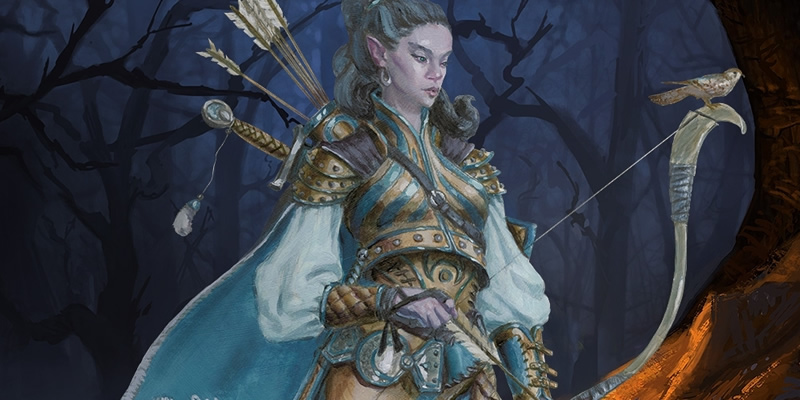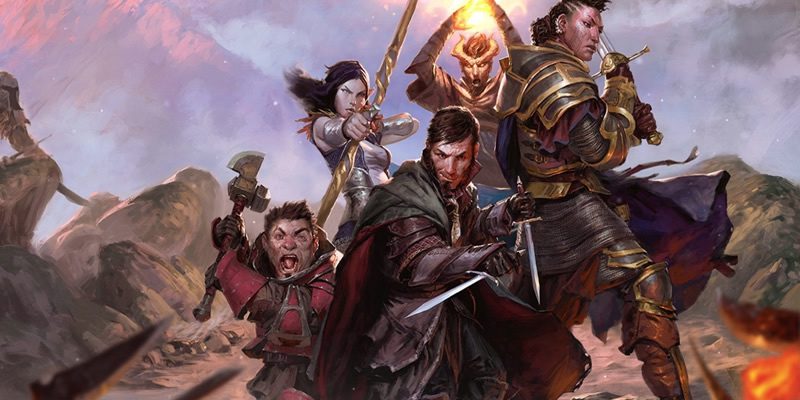Unearthed Arcana Breakdown: The Ranger, Revised

In today’s Unearthed Arcana article, Mearls returns to one of the most hotly discussed topics of 5e design: the ranger. This isn’t UA’s first take on an alternate ranger, either – and the blogging/third-party-publishing community has followed suit. That previous article lays out a lot of what WotC sees as The Issues, but the solution they presented was not particularly celebrated in the conversations I saw about it. To be fair, though, the core of the problem is that there’s probably less consensus on the ranger’s identity as a class than any other class in the game. In this article, I’m picking apart what I see in the document.
Over the past few days, Mearls has teased this article (game designers can be so cruel!) in his Twitter feed, so about like you’d expect, I’ve been on tenterhooks. Now that we can see the whole thing, I have a lot more context! It turns out that this revision is about 90% redefinition of features and 10% new content, which is interesting. The good side of this is that rules outside the ranger class, such as magic items, can still reference the names of ranger features for both the Original Ranger and the Extra Cripsy Ranger. The downside the same idea in reverse – when referring to features, if you only want to talk about the Original Favored Enemy feature, it requires constant clarification.
Let’s look at what’s been redefined. One of the biggest changes is that Favored Enemy got split into Favored Enemy and Greater Favored Enemy. Where Original grants three favored enemies (at 1st, 6th, and 14th), Extra Crispy grants one choice from one list at 1st, and one choice from a second, more fantastical and high-powered list at 6th. The first list only offers beasts, fey, humanoids, monstrosities, and undead. Treating “humanoids” as a single type for this purpose is straight-out shocking, and I can’t help but hope that gets split up a bit in final form. I expect that in most campaigns, humanoids are by far and away the most common foes throughout the course of play; undead are a somewhat distant second place. (Obviously, no statement is true for all games.)
The other big change is that the feature grants a flat +2 to damage rolls with weapon attacks against your favored enemy. A small and easily forgotten flat add? That seems like an odd violation of 5e’s general style. I’m not sure what the thinking is here, except that Mearls tweeted mentioning that the ranger is balanced on the assumption they’re never getting this bonus. I’ll have to hope for more commentary on this point once there’s a poll and a response.
A much smaller change is that you learn a new language, and it can be any language, not just one associated with the favored enemy. That sounds kind of weird, but it makes sense when you consider that most beasts and monstrosities (and many undead) don’t have the power of speech, much less a language of their own. Gaining a new language may not be a major mechanical advantage in the average campaign, but this change does solve that minor inequality.
Next up is another big change: Natural Explorer. This feature is one of my major sticking points in the Original ranger, and I am immensely pleased that they’ve reworked it here. Specifically, rangers are now good in all terrains, once they’ve traveled in them for an hour. This is a huge improvement over being useful in one terrain type out of eight, eventually scaling up to three out of eight. It reflects adaptability as a core element of the ranger’s training, and I love that. It also goes a lot further, and this is pretty amazing to see.
- Free passage through difficult terrain got looted from Land’s Stride.
- Advantage on initiative rolls is very nice. For a class that may be Dex-focused, even nicer.
- Advantage on attacks against enemies that haven’t acted yet is amazing. It’s half of the Assassin rogue’s Assassinate feature. This results in a ranger that is a phenomenal one-level dip for Thief or Arcane Trickster rogues – going first more reliably and gaining advantage on attacks is a huge boon over the life of a character. Other than the multiclassing exploit, I think this is a solid feature.
- Because you don’t have a favored terrain, an extra application of your proficiency bonus on Int and Wis checks related to it are necessarily gone. This is a fairly paltry trade for the three features listed above.
- The rest of the features remain the same.
I’m still sad that Fighting Style hasn’t been expanded to offer Protection or Great Weapon styles, and don’t really understand why they hedge on supporting shield rangers or greatsword rangers like that. Easy houserule, but still!
Next up is Primeval Awareness, another major flaw of the Original ranger. (For more analysis on this flaw, see Colin’s thorough examination.) Almost everything about this feature’s new form is an expansion of utility. First off, it allows animal empathy without spell use, which is a great support of theme. I see Mick “Crocodile” Dundee in the first half of this feature, and that makes me happy. Rangers now have primeval awareness of their favored enemies rather than unnatural creatures, which narrows overall function but fits it to the individual ranger a lot better. This sense also provides approximate distance and direction, if within 5 miles. This is the clause that fixed what was broken in the original version. There’s no question in my mind that this is a huge improvement.
Ranger Archetypes are now called Ranger Conclaves. It implies a story where “archetype” did not, even if it’s a small thing. I’ll handle the three Conclaves later on in this article.
Extra Attack is gone, and has been replaced by a Conclave feature. That’s kinda weird, especially since two of the three subclasses just get Extra Attack at this level, but it lets them make the Beast Conclave look less like a dilution of power. I’ll come back to this.
I mentioned Greater Favored Enemy before, and here it is. This sets you up to fight one of the bigger, more fantastical threats of mid-to-high-level D&D, without having to choose them at lower levels and be stuck with them. It also scales up the damage bonus of your Favored Enemy feature. A +4 flat add is more memorable than +2, I guess. I would still like a dice add more than a flat add, because it makes crits a little more interesting and I find dice easier to remember, but this is pretty nitpicky. Overall I like what goes on here.
Land’s Stride is completely gone. Its first half went to Natural Explorer, as I mentioned, while its second half is completely gone. (It didn’t come up that often in most campaigns, and will scarcely be missed.) In its place is Fleet of Foot, which lets you Dash as a bonus action. This is very good and will come up often, though any additional competition for bonus actions is a tough call for rangers and applies a lot of pressure in toward archers and away from two-weapon-fighting rangers. (Colin has commentary on this, too.) I like that this improves their skirmishing potential and helps them keep up with rogues, though it would help a lot if they had Disengage as an additional option here. They have to wait until 14th level to pick up the third part of Cunning Action (Hide as a bonus action, that is).
Hide in Plain Sight went from 1-minute setup to no setup, which honors the implication of its name a little better. It might strain believability to achieve such an effect in an action, but the fantastical things other classes get at this level of play makes this seem just fine. The degree of preparation that the Original version of the feature required is such that it shouldn’t have been a feature, but a default thing that anyone could try to achieve.
Vanish and Feral Senses are unchanged.
Foe Slayer used to be the only place you got a damage bonus against your favored enemies. Now it’s a once-per-turn boost to an attack or damage roll, equal to your Wisdom bonus. This is nice, and overall much better than the original version, but it’s still one of the least impressive 20th-level class features in the game.
Overall, the core of the class is a lot beefier, with a lot more going on at low to mid levels. It tapers off in compelling features as you advance, but that’s common across most classes, and is balanced by what goes on in the Conclaves. So let’s get to that part of the story.
The Beast Conclave
The Original Beast Master archetype was the other most derided part of the Original ranger. Its issues are too extensive to deal with here, but the short version is that the ranger gave up making their own attacks so that the companion could attack, where other archetypes were a clearer increase in power. A whole lot changes in this revision, starting with the types of animals you can choose – the list has narrowed somewhat. I’d like to see it broadened again, as there are no birds or other flying creatures on this list. More than that, it should incorporate some fantastical creatures – getting outlandish animal companions is one of the great appeals of playing a Hunter in WoW, after all. The companion becomes more of a rules chassis and less like its Monster Manual form, losing Multiattack but gaining the ranger’s proficiency bonus to everything that normally gains proficiency bonuses, as well as AC and damage rolls. This is a pretty solid way to standardize the creatures’ power levels; I also appreciate that there’s a thematic reason offered for stripping Multiattack. On the other hand, the listed options for animal companions are not created equal. As others are pointing out, black bears have a decisive starting advantage over other beasts, and while that lead is diluted as you advance, it’s always present.
The companion also gains hit dice and ability score points when the ranger does. That should be a huge increase in durability (as Con now matters, and scales), which was one of the major shortcomings of the previous version. They even remembered to make it scale up when you gain non-ranger levels, so multiclass rangers stay viable. It acts on a turn of its own, which is yet another huge improvement. The beast has its own personality features, which is cool. Finally, it gains your bonuses from Favored Enemy and Greater Favored Enemy, which is good for making sure it matters to every Conclave.
The Beast Conclave never teaches Extra Attack, and it’s the only one of these that doesn’t. However, Coordinated Attack has changed to emphasize the beast as a main damage-dealing component of the team – it has its own turn and attacks then (if you tell it to), and again on your turn when you Attack, by spending its reaction. It does have some stiff competition for its reaction, later in the Conclave progression. It also means that actions spent casting a spell or doing anything else reduce the beast’s damage output.
Because the beast doesn’t need creative ways to do more stuff on the ranger’s turn anymore, Exceptional Training is gone and replaced with Beast’s Defense at 7th level. This is another great survivability increase.
At 11th level, the beast gets Storm of Claws and Fangs, which is a fancy way to say that it can spend its action to make the equivalent of a Whirlwind Attack. The scale of improvement over Bestial Fury in the original Beast Master is incredible, but needed.
Share Spells is gone, which is a bit of a shame, but it’s replaced with Superior Beast’s Defense. This is the competition for the beast’s reaction that I mentioned. Most of the time, you want to save your reaction to deal more damage, but I can at least imagine times when this is the right answer.
Overall, the Beast Master went from underwhelming to extremely competitive. I would play one tomorrow and expect to have a good time doing it. Every element is more compelling – I cannot say enough good here. In the right circumstance, the Beast Conclave ranger may deliver more attacks per round – a theoretical peak of 11 attacks in a round, or 12 with haste (8 from SoC&F, 1 from ranger’s action, 1 from ranger’s bonus action to fight with two weapons, 1 from the beast’s reaction). Getting to apply the ranger’s proficiency bonus to damage in nine of those cases doesn’t hurt either. It is still the case that relying on a beast companion means that a bunch of your core combat features might be unavailable because your beast is dead or socially unacceptable (“The giant weasel won’t go into the meeting with the duke, out of professional courtesy”). That’s not really fixable, but the ranger is still fairly potent without the beast. Better off than a wizard in a wild or dead magic zone, anyway.
The Hunter Conclave
The Hunter Conclave didn’t change at all, except that it now grants Extra Attack instead of the core of the class granting that. The problem with the Hunter continues to be that it wants you to choose whether you are melee or ranged, and that’s contrary to class theme and ideal compelling gameplay design. I would prefer that the 11th level feature were either Extra Attack 2, or granted both Whirlwind Attack and Volley. Choosing between the two at the time you gain the level is a pointless limitation, since you could never use them simultaneously.
The Deep Stalker Conclave
The Deep Stalker Conclave is a close cousin of the Deep Stalker we saw in Light, Dark, Underdark! last year. Underdark Scout is still strong, but instead of letting you hide as a bonus action (and stealing thunder from Vanish much, much later), it makes you better at hiding from creatures with darkvision. Using this part of the feature well requires a subtle understanding of 5e’s rules on lighting conditions and how darkvision interacts with them. I wonder how this interfaces with Devil’s Sight and other darkvision-but-better features.
Deep Stalker Magic is the same, and I still don’t get how it fits the theme. After that you gain Extra Attack at 5th level. Iron Mind at 7th level and Stalker’s Flurry at 11th level are unchanged. Stalker’s Dodge has a more complicated implementation of when you declare that you are using it, theoretically requiring the DM to announce the number on the die but not whether the attack is a hit or a miss. This generally slows down resolution at the table and should be avoided, in my view; I’d rather see plain old Uncanny Dodge here. Overall, the Deep Stalker is balance-neutral compared to its predecessor, but a little more complicated.
Conclusion
I am a huge fan of this revision, all things considered. There are a few flaws – humanoids as a favored enemy option, some clearly-superior beast companions, some increased pressure on an already tight action economy that disproportionately affects one fighting style – but on the whole it’s immensely more viable. The improvement in the Beast Conclave is probably the most striking part of the whole thing, but Natural Explorer has firmly crossed from being solely about exploration into offering serious combat throughput as well.
When Mearls started revising the ranger, he laid out Guardian, Skirmisher, and Wanderer as three key themes of the ranger. The combat sense of Guardian didn’t see a lot of help here, as Hunter is the only thing that supports it directly, and Hunter didn’t change, though the increased toughness of beasts makes Beast rangers fairly strong at locking down areas of a battlefield. The damage boost against favored enemies may point to this theme as well. I would urge them to push this just a little further with more support for shield rangers, and more spells to improve guardianship themes. The changes to Primeval Awareness are great for out-of-combat definitions of Guardian, including ways to avoid fights completely. Skirmisher and Wanderer saw a huge boost in the Natural Explorer rework, and in trading Land’s Stride for Fleet of Foot, and in making Hide in Plain Sight much easier to use.
The text says that there will probably be a few more changes between this document and the final. I think they’re in a really good place here, and I would houserule this class only slightly for my own campaign. (Humanoids are a great majority of the opposition in my campaign, see.)
I’ll be curious to see whether the revised ranger makes it into the SRD. I dearly hope so – as someone who has released a PDF of ranger archetypes (and thank you so much to everyone who has bought a copy!), I would like to update the work to fit with the revision.



